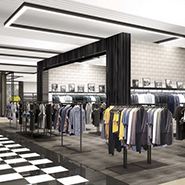- About
- Subscribe Now
- New York,
June 8, 2015

 Men's section of Bloomingdale's in Palo Alto
Men's section of Bloomingdale's in Palo Alto
The convergence of digital and physical retailing, rather than a zero-sum game between channels, is shaping up to be the future, according to a new report by TimeTrade.
Consumers still appreciate being able to examine products in-person, try stuff on to check if it fits, make informed choices, enjoy the atmosphere of a store and sometimes ask sales associates questions. Although digital has made consumers more concise in their shopping habits, due to extensive research behind-the-scenes, it has not dented in-store dominance.
“The bottom line is customers value the personal experience of the physical store,” said Gary Ambrosino, CEO of TimeTrade, Boston. “We found that shoppers have done their shopping or discovery online, then go into the store to get help with their final purchase decision.
“We see retail convergence – the coming together of digital and physical retailing – as a game changing trend,” he said.
“Traditional e-tailers are opening brick-and-mortar locations because they understand very well the highly personal service they can offer in a store and traditional brick-and-mortar retailers are creating more personal, digital-savvy experiences in the store to better serve today’s shopper.”
"The State of Retail 2015" includes information from 1,029 consumer surveys.
Set in their ways
Eighty-five percent of respondents said that they shop in-store because they can see and feel the product before purchase. Oftentimes, a consumer shopping online will order an item that seems perfect, only to find out it fits poorly or is just not as nice as what they had expected, leading to frustration and more waiting as the product is returned and another is ordered.
Since shopping is partly about instant gratification, the protracted process of online shopping can seem self-defeating.
A symptom of this realization is diminishing growth in mobile spending. While 42 percent of consumers have never purchased anything with a mobile device, only 13 percent said that they would make a purchase on mobile in the future.
As consumers have poor shopping outcomes online and learn more about security issues, they are coming out in favor of shopping in-store.
Harrods' "Shoe Heaven"
However, the majority of consumers still research heavily on their mobile devices before heading to a retailer. Fifty percent of consumers use mobile to research, 60 percent to compare prices and 46 percent to find the nearest store.
Furthermore, 38 percent of consumers know exactly what they want to buy after researching online.
However, the majority, 53 percent of respondents, said that after researching online for a purchase, they have narrowed their selection to two or three products and then need in-store validation to make the final decision.
This is where the convergence of digital and physical retailing comes into play.
Nearly 90 percent of respondents said they are more likely to make a purchase if assisted by a knowledgeable sales associate, and 50 percent said that what they appreciate the most from a sales associate is smart recommendations.
If identical products exist at four different stores, 63 percent of consumers will base their purchase decision not on price but on superior customer service.
Sales associate
Also, 82 percent of consumers will purchase more than they had originally intended when going to a physical location.
Just as mobile helps consumers shop in-store, it helps sales associates become more effective.
As Ed Brill of IBM wrote for this Web site, "The retail customer experience is a shifting collection of moments that occur while shopping online, in-person at a store or while resolving an issue via a contact center.
"Today, all of these channels involve mobile to varying degrees – whether customers are comparing prices or checking product reviews, making a purchase using a mobile wallet, or receiving personalized promotion offers via text or through social media channels" (see story).
Across borders
The collapsing divide between mobile and in-store is almost all positive and can be seen across borders.
A report by Boston Consulting Group explores the online shopping tendencies of Chinese consumers such as a widely-held penchant for researching products at length.
“The Chinese Digital Consumer in a Multichannel World” report explains that the number of Chinese online shoppers is expected to reach 380 million by 2016, which presents brands with huge swaths of potential customers. Any giddiness marketers feel at such a prospect should be tempered by the fact that only .5 percent of online activity is conducted on brand or company Web sites (see story).
Indeed, digital may have plateaued in its cannibalization of in-store sales, setting forward-looking shopping centers up to capture a large portion of the retail market.
Consumers mainly use digital to facilitate in-store purchases through interactive touchpoints and research. Combined with the desire among brands for greater autonomy, shopping centers find themselves in fertile territory and places such as Bal Harbour Shops in Florida are capitalizing on the changing climate with immersive, rejuvenating environments (see story).
However, a successful retail presence will be contingent on how well mobile is integrated.
"With exponential adoption rates of mobile devices, harnessing the opportunity across the customer journey will be the ultimate game changer,” says Sheryl Kingstone, Director at 451 Research.
"Retailers need to bridge digital interactions with brick and mortar interactions with new innovative technologies along business process changes," she said.
Final Take
Joe McCarthy, staff reporter on Luxury Daily, New York
Share your thoughts. Click here